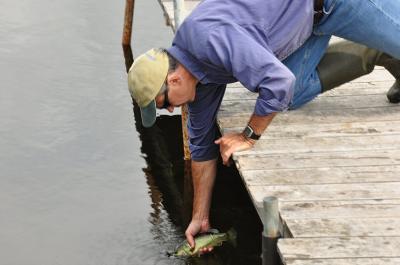(Millbrook, N.Y.) By closely monitoring environmental conditions at a remote Wisconsin lake, researchers have found that models used to assess catastrophic changes in economic and medical systems can also predict environmental collapse. Stock market crashes, epileptic seizures, and ecological breakdowns are all preceded by a measurable increase in variance—be it fluctuations in brain waves, the Dow Jones index, or, in the case of the Wisconsin lake, chlorophyll.
In a paper published this week in the journal Science, a team of ecologists is the first to show that by paying attention to variability in key ecosystem processes, scientists can detect the early warning signs that herald environmental collapse. Insight into regime shifts—the reorganization of an ecosystem from one state to another—is critical to identifying ecosystems that will fail without intervention.
"Early warning signs help you prepare for, and hopefully prevent, the worst case scenario," notes contributing author Jonathan J. Cole, a biogeochemist at the Cary Institute of Ecosystem Studies. "We are surrounded by problems caused by ecological regime shifts—water supply shortages, fishery declines, unproductive rangeland—our study shows that there is promise in identifying these changes before they reach their tipping point."

Through extensive environmental monitoring, the research team identified the early warning signals of a regime shift in this study lake.
(Photo Credit: Cascade Project Photo Archive)
The team, led by Stephen Carpenter, a limnologist at the University of Wisconsin-Madison, triggered a regime shift in a Wisconsin lake by introducing a top predator. The study lake was originally dominated by small fish, such as golden shiners, that feed on tiny free-swimming invertebrates. Researchers destabilized the lake by adding largemouth bass. The goal: to observe the cascade of environmental changes that eventually led to a food web dominated by piscivorous, or fish-eating, fish.
Throughout the lake's three-year manipulation, its chemical, biological, and physical vital signs were continuously monitored to track even the smallest changes. It was in these massive sets of data that researchers were able to detect the signals of the ecosystem's impending collapse.
As the number of bass increased, smaller fish spent more time swimming in groups near the shoreline, to avoid being eaten. Freed from predation, invertebrates living in the open water shifted to forms that were larger in size. Phytoplankton, the preferred food of these invertebrates, became more variable. Bass populations increased, as they fed on the smaller fish. Within three years the lake's food web had completely shifted to one dominated by fish-eating fish and larger free-swimming invertebrates

Mike Pace, one of the paper's authors, releases a largemouth bass into the Wisconsin study lake.
(Photo Credit: Cascade Photo Archive)
More significantly, more than a year before the food web transition was complete, variance in chlorophyll measurements was a reliable early warning indicator of the impending food web regime shift.
"The field experiment is a validated statistical early warning system for ecosystem collapse. With more work, this could revolutionize ecosystem management," Carpenter comments. The catch, however, is that for the early warning system to work, continuous monitoring of an ecosystem's chemistry, physical properties, and biota are required. The chlorophyll red flag would only work for identifying food web shifts in freshwater lakes.
Such an approach may not be practical for every threatened ecosystem, says Carpenter, but he also cites the price of doing nothing: "These regime shifts tend to be hard to reverse. It is like a runaway train once it gets going and the costs, both ecological and economic, are high."
Cole concludes, "Automated sensors, remote sensing technology, and computing are making continuous environmental monitoring much more accessible. And identifying early warning signs across a variety of ecosystems could help us prioritize management efforts."

To reveal early warning signs, researchers paid close attention to the study lake's chemical, biological and physical vital signs.
(Photo Credit: Cascade Photo Archive)